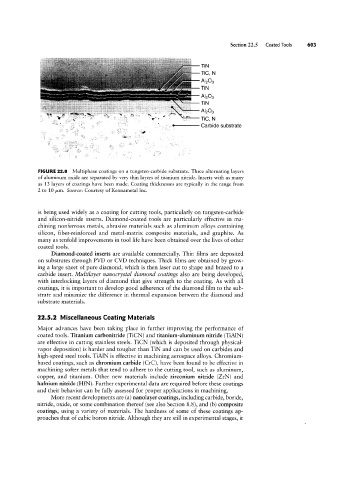Page 622 - 04. Subyek Engineering Materials - Manufacturing, Engineering and Technology SI 6th Edition - Serope Kalpakjian, Stephen Schmid (2009)
P. 622
Section 22 5 Coated Tools 0
- TiN
Tao, N
_ /-\|2o3
TiN
- AI2O3
- /-\|2o3
- TiN
N
~.o
, Carbide substrate
iii? Wfsfia iz. U2 1
.ir
"T
af'
iiiléiéji g... `T` i, Vi _
1- fs, ,.`~
;
.f
FIGURE 22.8 Multiphase coatings on a tungsten-carbide substrate. Three alternating layers
of aluminum oxide are separated by very thin layers of titanium nitride. Inserts with as many
as 13 layers of coatings have been made. Coating thicknesses are typically in the range from
2 to 10 um. Source: Courtesy of Kennametal Inc.
is being used widely as a coating for cutting tools, particularly on tungsten-carbide
and silicon-nitride inserts. Diamond-coated tools are particularly effective in ma-
chining nonferrous metals, abrasive materials such as aluminum alloys containing
silicon, fiber-reinforced and metal-matrix composite materials, and graphite. As
many as tenfold improvements in tool life have been obtained over the lives of other
coated tools.
Diamond-coated inserts are available commercially. Thin films are deposited
on substrates through PVD or CVD techniques. Thick films are obtained by grow-
ing a large sheet of pure diamond, which is then laser cut to shape and brazed to a
carbide insert. Multilayer nanocrystal diamond coatings also are being developed,
with interlocking layers of diamond that give strength to the coating. As with all
coatings, it is important to develop good adherence of the diamond film to the sub-
strate and minimize the difference in thermal expansion between the diamond and
substrate materials.
22.5.2 Miscellaneous Coating Materials
Major advances have been taking place in further improving the performance of
coated tools. Titanium carbonitride (TiCN) and titanium-aluminum nitride (TiAlN)
are effective in cutting stainless steels. TiCN (which is deposited through physical-
vapor deposition) is harder and tougher than TiN and can be used on carbides and
high-speed steel tools. TiAlN is effective in machining aerospace alloys. Chromium-
based coatings, such as chromium carbide (CrC), have been found to be effective in
machining softer metals that tend to adhere to the cutting tool, such as aluminum,
copper, and titanium. Other new materials include zirconium nitride (ZrN) and
hafnium nitride (HfN). Further experimental data are required before these coatings
and their behavior can be fully assessed for proper applications in machining.
More recent developments are (a) nanolayer coatings, including carbide, boride,
nitride, oxide, or some combination thereof (see also Section 8.8), and (b) composite
coatings, using a variety of materials. The hardness of some of these coatings ap-
proaches that of cubic boron nitride. Although they are still in experimental stages, it

